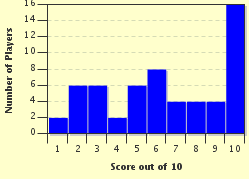Quiz Answer Key and Fun Facts
1. Any elementary student who knows how to multiply will eventually be able to understand that a square root of a number, when multiplied to itself, will result in the number. For example, the square root of 16 is 4, because 4 x 4 = 16. However, the square root of a negative number is far more difficult to visualize. What specific letter is often assigned to represent the square root of -1?
2. Numbers that contain i are called imaginary, while numbers that don't contain i are called real. What term is used to refer to an expression that combines both real and imaginary terms?
3. Whenever you learn a new branch of mathematics (or of most things, actually), a good way to start is to try to look for similarities with things you already know. For example, the first thing we learn to do with (real) numbers is to add and subtract them. As it happens, the process is exactly the same for imaginary numbers. Just as 3 + 4 = 7, so does 3i + 4i = 7i. Now, what is 9i - 7i?
4. If adding and subtracting imaginary numbers is similar to real numbers, what happens when the numbers to be added or subtracted are complex? What is (2 + i) + (1 + 3i)?
5. Now that we've covered addition and subtraction, let's move on to multiplication of imaginary numbers. What would one get multiplying 3i x 5i? Remember that if i is the square root of -1, i x i = -1.
6. There is one interesting pattern that can be seen when i is multiplied to itself several times. By definition, i^2 = i x i = -1. Meanwhile, i^3 = i^2 x i = -i. Finally, i^4 = i^3 x i = 1. If one were to continue, i^5 = i, i^6 = -1, and one would soon realize that this sequence of i, -1, -i, 1, repeats again and again. Knowing this, what is the value of i^400?
7. We've talked about multiplying imaginary numbers, but what happens when one of the factors is complex? Simplify (1 + 2i)*(3i) by multiplying the imaginary factor 3i to 1, then multiplying 3i to 2i, then adding the results.
8. Now we move on to the last of the four basic operations. Similar to multiplication, the real and imaginary components of a complex number can be individually divided by the given divisor. Knowing this, what is (8 + 6i)/2?
9. Now that you know the basic operations for complex numbers, try combining the knowledge you've gleaned from multiple questions. Simplify this expression (-5 + 3i)*2i + (4 - 7i)?
10. When adding long series of numbers, one technique is to group them in such a way that they cancel out. Give it a try: i + i^2 + i^3 + i^4 + .... + i^40 + i^41?
Source: Author
Sedho7
This quiz was reviewed by FunTrivia editor
WesleyCrusher before going online.
Any errors found in FunTrivia content are routinely corrected through our feedback system.


